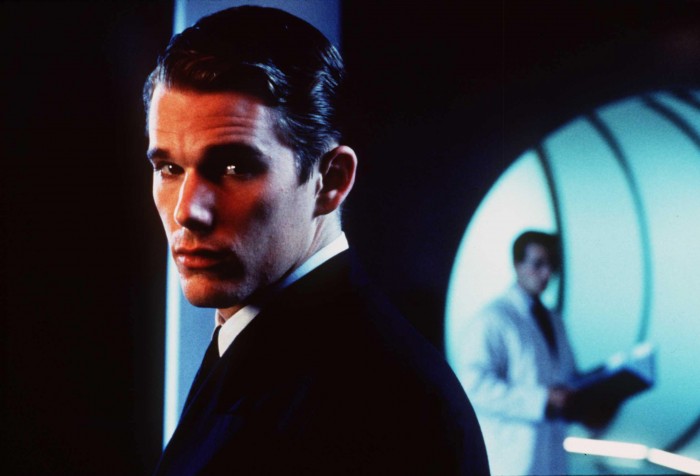Engineering the perfect astronaut
Some scientists are thinking about what human space travelers will look like in the future. They might be extra-small and radiation-proof.


At the International Astronautical Congress last September, in Guadalajara, Mexico, Elon Musk convinced many die-hard space engineers he could get a fleet of private rockets filled with thousands of people to Mars.
Musk’s speech was long on orbits, flight plans, and fuel costs. But it was short on how any of those colonists would survive. In fact, the Mars journey would likely be a dead end. Bathed in radiation and with nothing growing on it, the Red Planet is basically a graveyard.
Recently, a few scientists have started to explore whether we might be able to do a little better if we created new types of humans more fit for the travails of space travel. That’s right: genetically modified astronauts.
Let’s be clear. No one is trying to grow an astronaut in a bubbling vat somewhere. But some far-out ideas once relegated to science fiction and TED Talks (here and here) have recently started to take concrete form. Experiments have begun to alter human cells in the lab. Can they be made radiation-proof? Can they be rejiggered to produce their own vitamins and amino acids?
One person looking at the idea is Christopher Mason, a member of the Department of Physiology and Biophysics at Weill Cornell Medicine. In 2011, Mason came up with what he called a “500-year plan” to get humans off Earth. In it, genetic modification plays a big role. “I think we have to consider it for people that we send to other planets,” he says. “We don’t know if it’s a slight nudge to existing gene expression, or a whole new chromosome, or finally a complete rewriting of the genetic code.”
Mason says there’s a decade or two of work left just to find out what effect space travel has on your genes, and which ones might be okay to change and which should be on a “do not disturb” list. His lab participates in NASA’s Twins Study, which is tracking physiological changes to an astronaut who was sent to the International Space Station for a year while his twin brother stayed on Earth. So far, that’s about as close as NASA has gotten to the subject of GM astronauts—one that still hasn’t been broached in any official agency document.
Yet Mason says his lab is ready to take an initial step. Space is full of rays and fast-moving particles that damage DNA. So he’s working on radiation-proofing human cells. His students are taking cells and adding extra copies of p53, a gene involved in preventing cancer that’s known as the “protector of the genome.” Elephants have many extra copies of p53 and hardly ever get cancer, so maybe astronauts should have them too. Mason says he recently submitted a proposal to NASA to send the modified cells to the space station. “There is not a genetic engineering astronaut’s consortium or anything, but maybe we should start one,” he says.
Gattaca
All this has become easier to think about because it has become easier to do. In 2015 we published an article, “Engineering the Perfect Baby,” about the fact that gene editing, especially with a technology called CRISPR, had suddenly made it possible to easily change the genes in a human embryo. For the first time, we faced the real possibility of genetically modified people.
Since then, scientists in China and Europe have begun editing embryos to see how it works. Would it be ethical to then actually make a gene-fixed baby? The U.S. National Academy of Sciences this year said yes, heritable genetic changes could be considered to avoid disease, but only in a few situations and under very strict supervision. The organization opined that under certain rare circumstances in which a couple could not otherwise have a healthy child, it would be acceptable to create a GM human being.
Mason thinks that space travel will offer a second, very powerful argument in favor of genetically modifying people. “You can’t send someone to another planet without genetically protecting them if you are able to,” he says. “That would also be unethical.”
But putting astronauts in the mix might also open the door to “enhancement.” For now, the experts remain dead set against using gene editing to make a child who is smarter or endowed with perfect eyesight. But let’s face it: NASA already “selects” people according to just such criteria, accepting only 14 of 18,300 applicants to its latest class of astronauts. Maybe you have seen the movie Gattaca? Only supermen with topped-off genomes are allowed to travel to Titan, while the genetic losers, called “in-valids,” stare up in envy as the rockets lift off. Like most good science fiction, the 1997 film is not so far from reality.
Genetic wish list
To think about surviving in space, a term from the science of genetics—“fitness”—will come in handy. It doesn’t mean that you’ve spent an hour on the treadmill at Equinox. In genetics, the fitness of an organism is how well it can thrive and reproduce in a given environment.
The fitness of a human in space or on Mars is extremely low. Just picture an astronaut encased in a space suit with the right amount of oxygen, the right amount of nitrogen, and the right temperature. The purpose of that suit is to bring along the environment for which the astronaut’s genes make him or her fit.
Some scientists have already prepared a catalogue of genes that might help. A Boston company called Veritas Genetics is offering to sequence anyone’s genome for $999. And one of the things that Veritas will give you is a report on your “space genes.” Do you have the specific variant of EPAS1, common to Tibetans, that lets you get by with less oxygen? How about the natural mutation that results in huge, extra-lean muscles, which might counter atrophy? Another DNA variant is associated with good problem-solving skills and low anxiety. That’s just the sort of temperament that made Matt Damon’s implausible survival heroics possible in The Martian.
You’d be unusual if you had any one of these mutations. And the chances are billions to one that you have all of them. That’s why to get them all into one astronaut—the perfect astronaut—we might want to add them, probably before birth, and maybe using a technology like CRISPR. George Church, the big-bearded Harvard University genetics powerhouse and all-in futurist who founded Veritas, circulates a similar list of “rare protective gene variants relevant to an extraterrestrial environment.” Call it a wish list.
What other kind of adaptations could we install into our race of astronauts? If you leave some large elephants on an island and come back 10,000 years later, what you’ll find is a bunch of small elephants. They’ll have adapted to the lack of surface area and shortage of food. The phenomenon is called “island dwarfism.” Under the Mars domes, smaller might be better too. There’s probably not that much space, and every pound of provisions NASA takes into Earth orbit costs $10,000. That means the perfect astronaut probably isn’t just twice as strong as the average person but half as big. (Church, who is 6'5", notes that he was once told by NASA not to bother applying because he was too tall.)
Prototrophic humans
Let’s take the modifications even further, as some scientists say we might need to. If you ate breakfast cereal this morning, you might have looked at the side of the box, where it says things like “Vitamin C—10% Daily Value.” The “essential” nutrients and vitamins listed on the box are so called because the human body can’t make them. Instead, we have to eat organisms that do, like plants, fungi, or bacteria. These organisms are classified as “prototrophs,” meaning they synthesize everything they need from minimal starting ingredients like simple sugars or what’s in the soil.
Of course, eating rocks would be a pretty useful skill if you were living on Mars. And would you think I was kidding if I said scientists are looking into it? I am not kidding. In 2016, Harris Wang of Columbia University gave a talk titled “Synthesizing a Prototrophic Human” at a large off-the-record meeting of synthetic biologists organized by Church at Harvard Medical School. It could be pretty interesting for space travel, Wang told the group, if humans could subsist on sugar water.
Despite the title of his talk, when I reached Wang by phone he wanted everyone to know he’s not actually synthesizing humans or astronauts and doesn't have plans to. That’s still many, many years away, if ever. “I don’t want it said that I am making green people, and I am not suggesting we do this any time soon. But I am suggesting that if you want to do intergalactic travel, you need to solve the problem of being totally self-sufficient,” he says. “We are putting humans in very extreme conditions, and from that perspective this seems to be one idea for a long-term plan.”
Wang says it's not certain if the concept can even work. In his lab, researchers are trying to get human kidney cells to synthesize the nine amino acids our bodies don’t normally make, starting with the simplest one, methionine, manufactured by adding a single gene. If that works, he’ll move on to tryptophan, phenylalanine, and vitamins D, C, and B. Altogether, creating a prototrophic human cell would require around 250 new genes.
Creating astronauts able to make their own essential nutrients would obviously be immensely complicated. Yet as complex as it is, it might be less challenging than the alternatives, such as terraforming a planet or bringing along a space ring complete with an atmosphere, plants, and livestock grazing overhead. Wang told me it would also be interesting if space travelers could perform their own photosynthesis, turning light into food. But any human able to do so would hardly be human, he admits. To produce enough energy, a person would need to be as flat as a leaf and about the size of a playground.
The ability to alter the DNA of a human embryo has created a global debate over whether it would be right or wrong to genetically modify people here on Earth, to enhance their fitness for this planet. People have strong views. Some say the human species is not a laboratory rat. No to eugenics!! No to GM people!! Others say it might actually work—let’s check it out.
I don’t have the solution to this moral question. But I do know we’ll probably have to answer it before we can get off the planet.
Keep Reading
Most Popular
Large language models can do jaw-dropping things. But nobody knows exactly why.
And that's a problem. Figuring it out is one of the biggest scientific puzzles of our time and a crucial step towards controlling more powerful future models.
How scientists traced a mysterious covid case back to six toilets
When wastewater surveillance turns into a hunt for a single infected individual, the ethics get tricky.
The problem with plug-in hybrids? Their drivers.
Plug-in hybrids are often sold as a transition to EVs, but new data from Europe shows we’re still underestimating the emissions they produce.
Stay connected
Get the latest updates from
MIT Technology Review
Discover special offers, top stories, upcoming events, and more.